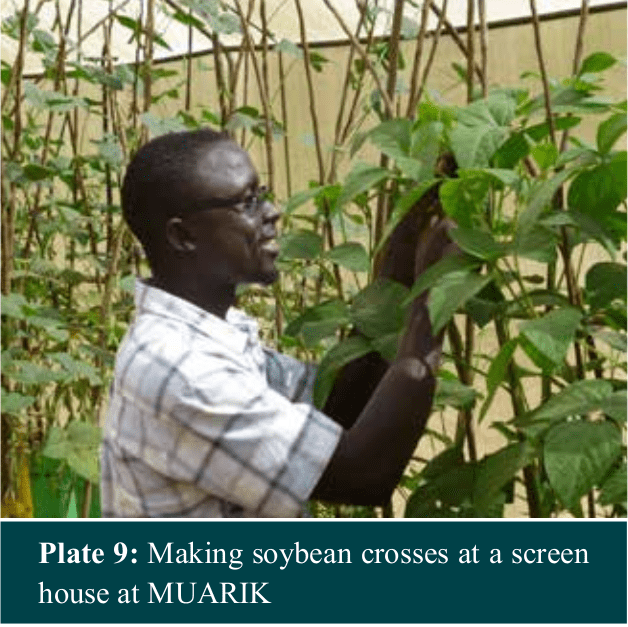Breeding Strategies
Breeding Strategies
The general objective of soybean research and development activities in Uganda has been to develop locally adapted resistant varieties and to disseminate seeds of improved varieties to the different seed stakeholders in the soybean value chain.
Breeding for resistance to rust disease
Diseases have hampered growth of the soybean sector in Uganda, however, soybean rust has been the most economically significant. At the onset of the soybean rust epidemic in 1996, all existing local and commercial cultivars showed susceptibility. The fungus spread rapidly to all soybean growing areas in Uganda. For this reason, the quest for rust-resistant varieties has been the prime focus of research in the country in the last 16 years.
Early advanced breeding efforts conducted between 1997 and 2004 deployed short and long term strategies that resulted in the identification of locally adapted resistant varieties. The short term strategy involved the importation and screening of over 200 accessions from the Asian Vegetable Research and Development Centre (AVRDC) and the International Institute of Tropical Agriculture (IITA), South Africa, the USA, and Zimbabwe. Meanwhile, the long term strategy comprised of the hybridization program, which involved development of resistant lines and elite adapted varieties. Table 1 is a summary of some of germplasm that was used in development of rust resistant soybean varieties in Uganda.
The tested accessions showed different levels of soybean rust resistance, with the accessions GC 00138-29 from AVRDC and TGX 1035 10E from IITA showing considerable resistance to the disease (Table 2). However, GC 00138-29 suffered from pod shattering and susceptibility to bacterial pustule (Xanthomonas campestris pv. glycines). Similarly, resistance of TGX 1035 10E was not uniform hence it was subjected to mass selection in order to constitute a variety that was early maturing and resistant to soybean rust disease. As a long term strategy, crosses of GC 00138-29 × Nam 2, GC 00138-29 × Duiker and TGX 1035 10E × Duiker (Plate 9) were made resulting in progenies which underwent development along the complete cultivar value chain. Some of the activities in the breeding process include single plant selection (Plate 10), and evaluation trials (onstation and on farm).

In 2004, the varieties Namsoy 4M and Maksoy 1N were released following extensive on-station testing and onfarm evalulations. Although Maksoy 1N and Namsoy 4M provided some relief to farmers, they also exhibited some limitations. The yield potential of Maksoy 1N was low compared to earlier cultivars Nam 1 and Nam 2. Meanwhile, Namsoy 4M was mildly susceptible to pod shattering, particularly during intense heat since it was a direct progeny of the shattering-susceptible GC 00138-29. More than 1000 breeding lines were obtained from other crosses between susceptible and resistant lines to produce better varieties for farmers as well as broaden the genetic base of resistance against rust which is known to challenge single resistance genes due to its high genetic variability. With further breeding work, other varieties were released, namely Maksoy 2N in 2008, Maksoy 3N
in 2010, Maksoy 4N and Maksoy 5N in 2013, and Maksoy 6N in 2017.
At present there are 25 lines at advanced level, 60 lines at preliminary level, 1015 breeding lines, 300 single plant rows, 400 segregating populations and 40 F1s. The plant breeding pillar of the centre is envisaged to ensure a sustainability base upon which a continuous process of population development and advancement lead to release and commercialisation of new products (varieties) that will also form a basis on which the pillar of seed systems and other center pillars depend.
